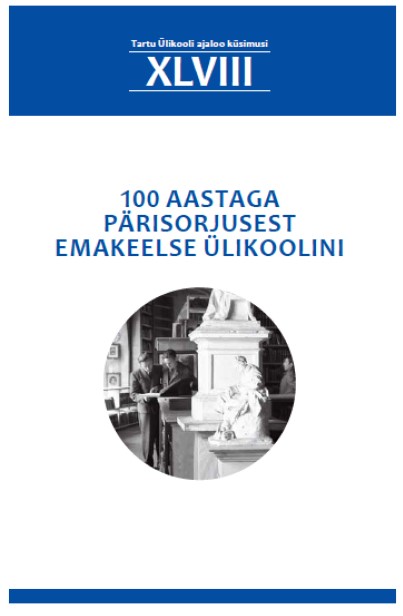Vabadussõjas langenud üliõpilaste mälestusmärk Tartu Ülikooli aulas
Estonian War of Independece Memorial to Fallen Students in the Assembly Hall of the University of Tartu
DOI:
https://doi.org/10.15157/tyak.v48i48.16893Abstract
The art collection of the University of Tartu includes a bronze sculpture
group of young men with a wounded fighter (KMM S 375) by
Jaan Koort (1883–1935). The work is situated in a wall niche in the
assembly hall of the University of Tartu main building with the accompanying
cast bronze text: „For the students who fell in the War of
Independence 1918–1920“ and an impression of the Estonian Cross
of Liberty. The story of the memorial has disappeared from common
memory, probably because the statue was completed only shortly before
the annexation of Estonia and the troubling times that followed.
The aim of this article is to reconstruct the story of the memorial,
specify when was it removed from its original place and describe its
complete reconstruction.
First monuments in honour of those who fell in the War of Independence
were erected in the early 1920s. These monuments and
memorials were primarily dedicated to the fallen Estonian soldiers.
Schools placed dedication plaques to those they lost mostly to their
assembly halls. The University of Tartu’s assembly hall in the main
building was also selected for this purpose, since it had been decorated
with artwork to represent the presence of state authority already
since the early 19th century.
Plans to erect a memorial for The War of Independence were made
in the University of Tartu before the 10th anniversary of the Estonian-
language university in 1928. It was decided to commission the
piece from the renowned Estonian sculptor Jaan Koort, but it became
apparent quite soon that the memorial was not going to be finished
on time. For unknown reasons, the memorial still had not been completed
in 1932 when a newspaper article about Koort’s plans to erect
a memorial with a sculpture group and 5 m wall relief was published.
In the summer of 1934 Koort accepted a post in the Soviet Union
where he suddenly died a year later. Plans for the memorial were
forgotten for some years.
It was planned to finish the memorial again in 1939, and the University’s
Administrative Board granted an additional 1,500 Estonian
kroons from the 1939/1940 budget for the purpose. Sculptor Ferdi
Sannamees was commissioned to finish the memorial based on the
example of the plaster sculpture group and original drawings left behind
by Koort. The memorial was opened on 1 December 1939 with
great festivity (photo 1) but in a much more modest form than originally
planned. Already in the autumn of 1940 the lettering and the
Cross of Independence were removed from the memorial after the
annexation of Estonia by the Soviet forces. The sculpture group was
restored to its original location at the beginning of the Nazi-German
occupation in 1941 (photo 2) but was apparently removed again in
the autumn of 1944 after Soviet power was reinstated in Estonia. The
statue was hidden in an unknown place. From the second half of the
1940s until the reinstatement of the sculpture group in 1989 Soviet
symbolic art was displayed in its place (photo 3).
In 1955, the Vice-rector of Economy of Tartu State University gave
nine artworks to Tartu State Art Museum to be stored temporarily
and one of them was the group of young men with a wounded fighter.
The sculpture group remained in the museum until 1974 when it
was returned to the university and was accepted to the collection of
the Museum of Classical Archaeology of Tartu State University. The
sculpture group was waiting for better times that arrived at the end
of the decade. In 1988 journalist Tarmo Vahter called for the sculpture
to be reinstated to its original place. The sculpture group was
placed back in the niche of the assembly hall in 1994 on the occasion
of the 75th anniversary of the Estonian-language university. Unbeknownst
to the authors, the lettering and the Cross of Liberty were
not reconstructed. The memorial was fully reconstructed 25 years
later for the centenary of the Estonian-language university. The work
was led by Ken Ird (historical research) and Maria Väinsar (technical
implementation) from the University of Tartu Museum. The bronze
casting and installation was managed by Bruno Kadak from Tormis
Disain (photo 4 and 5).
The memorial was originally thought to perpetuate the memory
of young men who gave their lives for the independence of Estonia
but it also implicitly served as a tool for engendering respect for the national culture of Estonia. This claim is supported by the fact that
the story of the memorial has always been closely linked with the anniversaries
of the Estonian-language university and that the Soviet
authorities consistently tried to ideologically redesign the memory
space at the site of the memorial. In addition to that, the memorial is
an emotionally efficient artwork and a perpetual acknowledgement
of the creative genius of sculptors Jaan Koort and Ferdi Sannamees
(photo 6).

